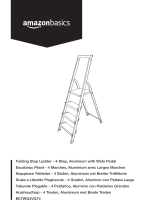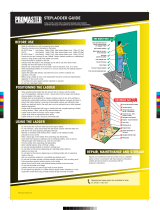Page is loading ...

Please retain these instructions
for future reference
BEFORE USE
•Read all instructions
on and accompanying
the ladder.
•Inspect the ladder
after delivery. Before
every use visually
check the ladder is not
damaged and is safe
to use.
•Do not use a damaged ladder.
•Do not use the
ladder if you are not
fit enough. Certain
medical conditions or
medication, alcohol
or drug abuse could make ladder use
unsafe.
•Ensure the ladder is suitable for the
task.
•Visually check the
ladder is not damaged
and is safe to use at
the start of each day
when the ladder is to
be used.
•Inspect ladder feet.
•For ladders that
require a stabiliser
do not use the ladder
until the stabiliser bar
has firstly been fully
attached and secured to the ladder.
•Do not use the ladder if
contaminated, e.g. with wet paint,
mud, oil, water or snow.
•Prevent damage of the ladder when
transporting e.g. by fastening and
ensure they are suitably placed to
prevent damage.
•For professional users regular
periodic inspection is required.
•For professional use, a risk
assessment shall be carried out
respecting the legislation in the
country of use.
•Do not modify the ladder design.
POSITIONING & ERECTING
THE LADDER
•When positioning the ladder, take
into account risk of collision with the
ladder e.g. from pedestrians, vehicles
or doors. Secure doors (not fire
exits) and windows where possible
in the work area.
•Warning! Electricity
hazard.
Identify any electrical
risks in the work area,
such as overhead
lines or other exposed
electrical equipment
and do not use the
ladder where electrical
risks occur.
•
Do not erect ladder on
contaminated ground.
Ladders shall not be
positioned on slippery
surfaces (such as
OI
LH
2O
ice, shiny surfaces or significantly
contaminated solid surfaces) unless
additional effective measures are
taken to prevent the ladder slipping or
ensuring contaminated surfaces are
sufficiently clean.
•Do not use the ladder
on an unlevel or
unfirm base.
•Ladder shall be on an even, level and
unmovable base.
•Do not lean the ladder
against unsuitable
surfaces. Leaning
ladder should lean
against a flat non-
fragile surface and should be
secured before use e.g. tied or use of
a suitable stability device.
•Only use the ladder
in the direction as
indicated.
UP
•Ladder shall be
erected at the correct
position, such as the
correct angle for a
leaning ladder
65-75º
(angle of inclination approximately
1:4) with the rungs or treads level.
•Keep the arrow
vertical for correct
working angle.
•Locking devices shall
be checked and be
fully secured before
use.
•Ladder should be stood on its feet,
not the rungs or steps.
•Leaning ladders with
steps, shall be used
that the steps are in a
horizontal position.
•Secure ladder at the top and bottom
wherever possible. If not, station
someone at the foot of the ladder.
•Do not move a ladder while standing
on it.
•Ladder shall never be repositioned
from above.
USING THE LADDER
•Do not exceed the
maximum total load
(load includes users,
tools, materials, etc.).
max.
150
kg
•Maximum number of
users on the ladder. max. 1
•Do not wear
unsuitable footwear
when climbing a
ladder.
•Do not ascend or
descend unless you
are facing the ladder.
•Keep a secure grip
on the ladder when
ascending and
descending. Maintain
3 points of contact
whilst working from a ladder or take
additional safety precautions if you
cannot.
•Do not stand on the
top three steps/rungs
of a leaning ladder. 12
3
•Do not overreach,
user should keep their
belt buckle (navel)
inside the stiles and
both feet on the same
step/rung throughout
the task.
•Avoid work that
imposes a sideways
load on ladders, such
as side-on drilling
through solid materials.
•Do not carry equipment
which is heavy or
difficult to handle whilst
using a ladder.
KG
•Equipment carried while using a ladder
should be light and easy to handle.
•Leaning ladders used
for access to a higher
level shall be extended
at least 1m above
the landing point and
secured if necessary.
•Do no step off the side
of leaning ladder onto
another surface.
•Use non-conductive ladders for
unavoidable electrical work.
•Secure doors (not fire exits) and
windows where possible in the work
area.
•Do not use the ladder outside in
adverse weather conditions, such as
strong wind.
•When outdoors, be cautious in windy
conditions.
•Ladders should only be used for light
work of a short duration.
•Do not spend long periods on
the ladder without regular breaks
(tiredness is a risk).
•Do not use the ladder
as a bridge.
•Take precautions against children
playing on the ladder.
REPAIR, MAINTENANCE &
STORAGE
•Repairs and maintenance shall be
carried out by a competent person
and be in accordance with the
producer’s instructions.
•Ladders should be stored in
accordance with the producer’s
instructions.
•Replacement spare parts are
available to order online at
wernerco.com.
LIST OF ITEMS TO BE
INSPECTED
For regular inspections, the following
items shall be taken into account-
Check:
The stiles/legs (uprights) are not
bent, bowed, twisted, dented,
cracked, corroded or rotten.
The stiles/legs around the fixing
points for other components are in
good condition.
The fixings (usually rivets, screws
or bolts) are not missing, loose or
corroded.
The rungs/steps are not missing,
loose, excessively worn, corroded or
damaged.
The hinges between the front and
rear sections are not damaged,
loose or corroded.
The locking stays horizontal, back
rails and corner braces are not
missing, bent, loose, corroded or
damaged.
The rung hooks are not missing,
damaged, loose or corroded and
engage properly on the rungs.
The guide brackets are not missing,
damaged, loose or corroded and
engage properly on the mating stile.
The ladder feet/end caps are not
missing, loose, excessively worn,
corroded or damaged.
The entire ladder is free from
contaminants (e.g. dirt, mud, paint,
oil or grease).
The locking catches (if fitted) are not
damaged or corroded and function
correctly.
If any of the above checks cannot
be fully satisfied, you should NOT
use the ladder.
STORAGE CHECKLIST
The important considerations when
storing a ladder (not in use) should
include the following:
Is the ladder stored away from
areas where it’s condition could
deteriorate more rapidly e.g.
dampness, excessive heat, or
exposed to the elements?
Is the ladder stored in a position
which helps it remain straight e.g.
hung by the stiles on proper ladder
brackets or laid on a flat clutter free
surface?
Is the ladder stored where it cannot
be damaged by vehicles, heavy
objects, or contaminants?
Is the ladder stored where it
cannot cause a trip hazard or an
obstruction?
Is the ladder stored securely where
it cannot be easily used for criminal
purposes?
If the ladder is permanently
positioned (e.g. on scaffolding),
is it secured against unauthorised
climbing (e.g. by children)?
PN115996-01 ©2019 WernerCo Rev. B 02/19
Extension Ladder
User Instructions
EN131
Ladder suitable for
Professional Use
WARNING!
Fall from the ladder
Werner UK Sales & Distribution Ltd.
Blackwater Trading Estate,
The Causeway, Maldon, Essex, CM9 4LJ
wernerco.com
/



